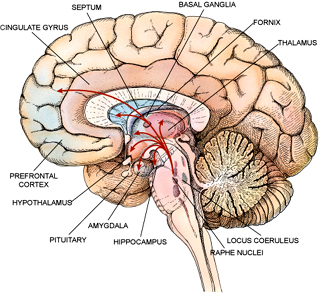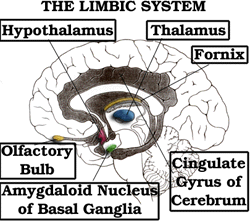



Structure of the Limbic System
The Limbic System, sometimes referred to as the "emotional brain" and its integrity is essential for emotional well-being. This system of the brain has more specifically been defined as "an interrelated group of . . . structures that are involved in the regulation of the emotional state, with the accompanying behavioral, physiologic, and psychologic responses." The three types of responses that result from emotional stimulation shall be discussed below. First, behavioral responses resultant of emotional stimulation can include some types of motor activity, "such as displaying anger, fighting . . . ,smiling or laughing, or verbalizing." Second, examples of physiologic responses involve changes in drives, such as appetite, thirst, or sexual behavior. Third, psychologic responses basically center around an alteration in the mental state of a person. A person may experience a change in the way they feel or react in response to a particular event, either becoming elated or tense, or on the other hand, sad or lethargic. The number of structures making up the limbic system as well as those areas of the brain that the limbic system influences include the following:
Basal Ganglia
Olfactory System/Bulb
Basal Forebrain
Limbic Forebrain
Limbic Midbrain
Cingulate Gyrus
Hippocampal Formation
Amygdala
Thalamus
Hypothalamus